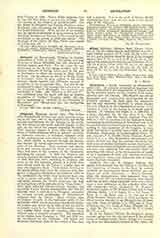

Abipones, MISSIONS AMONG the.—This Indian tribe, linguistically of Guaycuru stock, formerly roaming on the east side of the Parana river, was finally concentrated between the Rio Bermejo on the north, the Rio Salado on the south, and the Parana on the east, on the soil of the present Argentine Republic. Their customs appear to have been the same as those of South-American tribes in general: clanship, an elaborate animism, or fetishism, complete sway of the medicine-men over private and tribal matters; chiefs eligible, or imposed through the impression created by casual achievements combined with wiles of the Shamans. Their weapons were lances, bows, and arrows, though the lance was preferred. They had most of the customs of the Guaycurus, including the couvade. In 1641 the Abipones had already obtained the horse from the Spanish settlers. At that time they were, according to tradition, still north of the Rio Bermejo, whence it is likely they were driven south by the Tobas, a warlike tribe of their own linguistic stock. Their horses, thriving on the grassy plains, soon made the Abipones very dangerous to Spanish colonization by means of raids on the settlements, by which they increased their own stock of horses and cattle. In the first half of the eighteenth century, the Jesuits undertook the task of taming these unruly centaurs of the “Gran Chaco”. With great difficulty Fathers Casado, Sanchez, and especially Father Martin Dobrizhoffer, who was for eighteen years a missionary in Paraguay, succeeded in forming several settlements of Christianized Abipones near the Parana. These colonies were maintained in spite of the turbulent spirit of the neophytes, which caused incessant trouble with Spanish settlers and, above all, in spite of the murderous onslaughts made by the Tobas and Moobobis, strong and warlike tribes, upon the missions, when these showed signs of material prosperity. The expulsion of the Jesuits from Paraguay in 1768 and 1769 was the deathknell for the Abipones. The Tobas and Moobobis destroyed them in the course of less than half a century. It is to the work of Father Martin Dobrizhoffer, S.J., that we owe most of our knowledge of the Abipones.
A.D.F. BANDELIER

